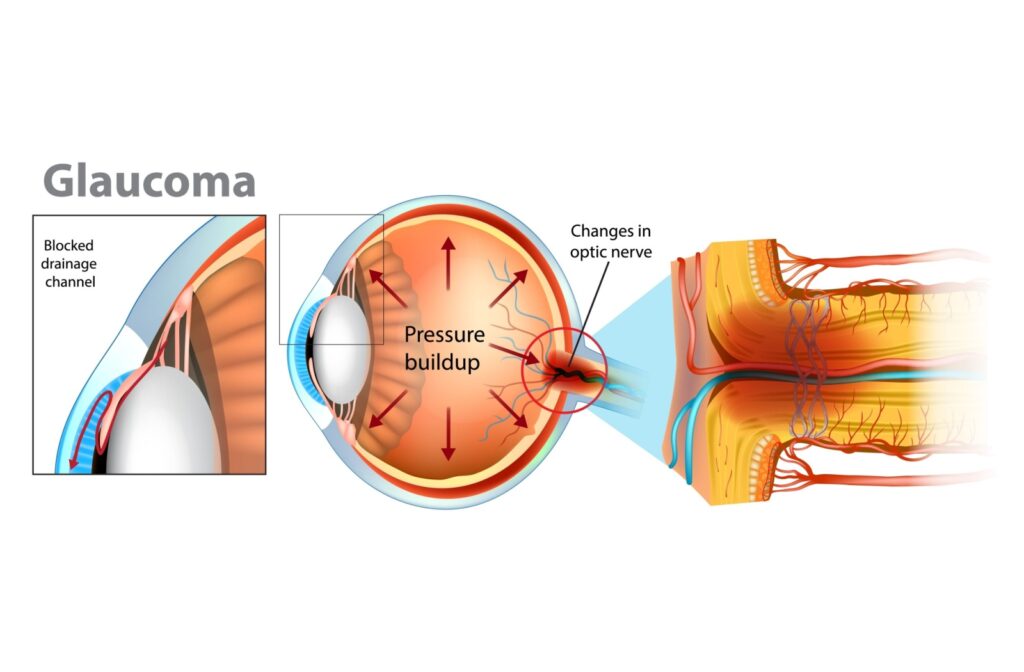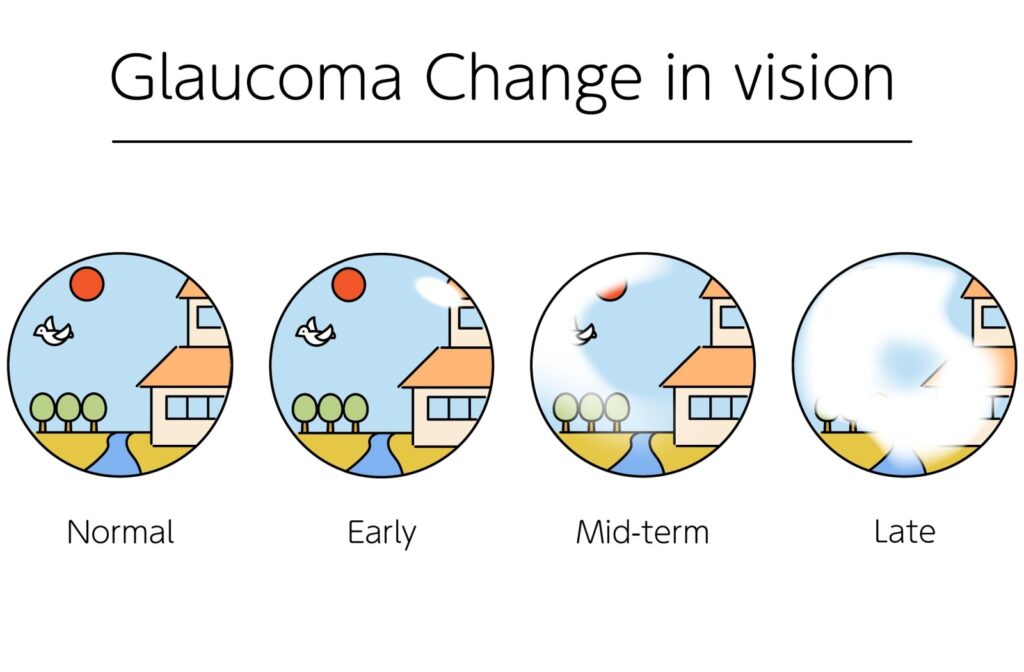Glaucoma affects over 400,000 Canadians, and many don’t know they have it until permanent vision loss occurs. This “silent thief of sight” can damage your eyes for years before you notice any symptoms, making early detection your best defence against vision loss. At our Barrie eye care practice, we see firsthand how regular comprehensive eye exams can catch this condition before it steals your sight.
The 7 early signs of glaucoma include gradual side vision loss, eye pain with headaches, nausea with eye discomfort, rainbow halos around lights, red eyes that won’t clear up, and in children — excessive tearing and growing nearsightedness. Recognizing these warning signs can help protect your family’s vision through prompt treatment.
What Is Glaucoma & Why Early Detection Matters
How Glaucoma Damages Your Vision
Glaucoma occurs when fluid pressure builds up inside your eye, damaging the optic nerve that sends visual signals to your brain. Think of your optic nerve as a cable with over one million tiny wires — when pressure damages these “wires,” you lose pieces of your vision permanently. Understanding glaucoma as an eye disease helps you appreciate why early intervention matters so much.
The damage typically starts with your side vision and works inward toward your central sight. Once glaucoma destroys part of your optic nerve, that vision loss can’t be restored. This is why understanding how glaucoma progresses silently is so important.
Why You Won’t Notice Early Changes
Your brain does an impressive job of filling in missing pieces of your vision, especially in your peripheral areas. You might not realize you’re losing side vision until significant damage has already occurred.
Most people with early glaucoma feel completely normal and can still drive, read, and go about their daily activities. This is why regular eye exams with your eye doctor are so important, we can detect changes before you notice them.
Benefits of Catching Glaucoma Early
Early treatment can slow or stop further vision loss in most cases. When we catch glaucoma in its beginning stages, simple eye drops or minor procedures can often control the pressure and protect your remaining vision.
The earlier we start treatment, the more vision you can keep for years to come. That’s why we encourage patients to think of regular eye exams as insurance for their sight.
Gradual Vision Loss You Might Miss
Changes in Your Side Vision
The most common early sign of glaucoma affects your peripheral vision, but these changes happen so slowly that you might not notice them at first.
- Patchy blind spots developing slowly
- Loss of peripheral vision
- Tunnel vision in later stages
You might find yourself turning your head more often to see things to your side, or you may bump into objects you didn’t see coming. Some patients tell me they started missing exits while driving or didn’t notice people approaching from the side. If you’re experiencing similar issues along with eye strain from prolonged screen time, specialized glasses can help reduce overall visual fatigue.
Central Vision Problems
While glaucoma usually starts with side vision loss, it can also affect your straight-ahead sight, particularly in certain types of the condition.
- Difficulty seeing things straight ahead
- Blurred vision that gets worse over time
If you notice your central vision becoming foggy or less sharp, especially combined with other symptoms, schedule a comprehensive eye exam with our team.
Sudden Symptoms That Need Emergency Care
Severe Eye Pain & Headaches
Acute angle-closure glaucoma causes sudden, severe symptoms that require immediate medical attention. This type of glaucoma happens when eye pressure rises quickly, creating intense discomfort.
- Intense eye pressure
- Pain that won’t go away with regular pain relief
- Headache with eye pain
If you experience severe eye pain along with a headache, don’t wait — seek emergency eye care immediately.
Nausea & Vomiting with Eye Pain
The sudden increase in eye pressure from acute glaucoma can make you feel sick to your stomach. Many people mistake these symptoms for a stomach bug or migraine.
When nausea and vomiting occur with eye pain or vision changes, contact our team immediately or visit the emergency room.
Rainbow Halos Around Lights
Seeing colourful rings or halos around lights, especially at night, can signal rising eye pressure. These halos look like rainbows circling light sources such as street lamps or car headlights.
While halos can sometimes happen with dry eyes or after certain eye surgeries, they can also warn of angle-closure glaucoma. Don’t ignore this symptom, particularly if it comes with eye pain or headaches.
Physical Changes You Can See
Red or Bloodshot Eyes That Won’t Clear Up
Persistent eye redness, especially when combined with pain or vision changes, can indicate rising eye pressure. Your eyes might look bloodshot, feel irritated, or appear swollen around the lids.
While red eyes have many causes, chronic redness that doesn’t improve with rest or over-the-counter drops deserves attention from your optometrist. Ongoing redness that affects just one eye or comes and goes over several days can signal increased pressure.
If you’re also experiencing dryness, consider scheduling a dry eye evaluation alongside your glaucoma screening.
Changes in Eye Appearance
Your eyes might appear different when pressure builds up. Some people notice their eyes look duller than usual or that one eye seems different from the other.
The whites of your eyes may take on a persistently bloodshot appearance, or your eyes might feel tender to touch. These physical changes often accompany other symptoms like pain or vision disturbances.

Warning Signs in Children (Though Rare)
While childhood glaucoma is uncommon, affecting about 1 in 10,000 births, early detection is critical because it can progress quickly and cause permanent vision loss if untreated. Parents should be aware of the following signs.
Increased Blinking & Tears Without Crying
Children with glaucoma often blink more than usual and may have watery eyes even when they’re not upset. Their eyes might seem sensitive to bright lights.
Parents sometimes notice their child squints frequently or rubs their eyes more than other kids. These signs can appear in babies and toddlers who can’t yet describe their symptoms. If you notice these changes, our children’s eye care services can provide specialized assessment and treatment.
Growing Nearsightedness
Rapidly worsening nearsightedness in children can sometimes indicate glaucoma. If your child’s prescription changes significantly in a short time, discuss this with your eye doctor.
While many children develop nearsightedness naturally, sudden changes combined with other symptoms deserve closer examination.
Headaches in Young Children
Frequent headaches in children, especially when combined with eye rubbing or light sensitivity, can signal eye pressure problems. Young children might become fussy or irritable without being able to explain why.
Pay attention if your child complains of headaches often or seems uncomfortable in bright environments.
When to Book Your Eye Exam
Schedule Regular Eye Exams
Adults should have comprehensive eye exams every years, or more often if you have risk factors for glaucoma. Regular checkups help catch problems before symptoms develop.
During your eye exam, we will check your eye pressure, examine your optic nerves, and test your peripheral vision. These tests can detect glaucoma years before you’d notice any changes.
Emergency Symptoms That Can’t Wait
Some glaucoma symptoms need immediate attention. Contact your eye doctor or go to the emergency room right away if you experience sudden severe eye pain, nausea with eye discomfort, or rapid vision loss.
Rainbow halos around lights combined with eye pain also require prompt care. Don’t wait to see if symptoms improve on their own.
Risk Factors That Increase Your Chances
Age & Family History
Your risk of glaucoma increases after age 60, and family history plays a significant role. If a parent or sibling has glaucoma, your risk is much higher.
Some ethnic groups, including people of African and Hispanic descent, face higher glaucoma risk at younger ages. Knowing your family eye health history helps your optometrist assess your personal risk.
Medical Conditions That Raise Risk
Diabetes, high blood pressure, and heart disease can increase your glaucoma risk. Severe nearsightedness and previous eye injuries also raise your chances. Patients with diabetes should particularly prioritize diabetic eye screenings to monitor for multiple eye conditions simultaneously.
If you have these conditions, discuss more frequent eye screening with your healthcare team.
Eye Injuries & Medications
Past eye injuries, even ones that seemed minor at the time, can lead to glaucoma years later. Certain medications, particularly long-term steroid use, can also raise eye pressure.
Always tell your eye doctor about previous eye injuries and current medications during your exam.
Steps to Protect Your Family’s Vision
Glaucoma doesn’t have to steal your sight. When caught early through regular eye exams, treatment can preserve your vision for years to come. Here’s how to protect yourself and your loved ones.
Make Eye Exams a Priority
Regular comprehensive eye exams are your best defence against glaucoma. During your visit, we check your eye pressure, examine your optic nerves, and test your peripheral vision—all before you’d notice any symptoms on your own.
Adults should have their eyes examined every year, but if you have risk factors like family history or diabetes, you may need more frequent monitoring. Don’t wait for warning signs to appear, by then, permanent damage may have already occurred.
Know Your Family History
Your family’s eye health history matters more than you might think. If a parent or sibling has glaucoma, your risk increases significantly. Take time to ask relatives about their eye health, including glaucoma, cataracts, and other conditions.
Share this information during your appointments so we can create a personalized screening schedule that fits your needs.
Schedule Your Glaucoma Screening in Barrie
Early detection saves sight. If you’ve noticed any warning signs, have risk factors, or simply haven’t had an eye exam in over a year, now is the time to take action.
Our team at Dr. Chris Schell uses advanced diagnostic technology to catch glaucoma in its earliest stages, when treatment is most effective. We’re committed to protecting your vision through comprehensive care and personalized treatment plans.Book your comprehensive eye exam today and give yourself the gift of healthy vision for years to come.



